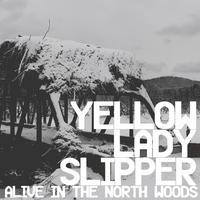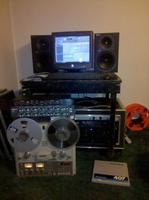Alive In The North Woods: Technical Details
Yellow Lady Slipper recently released their (our) new live disc, called Alive In The North Woods. For those interested, here are some technical details about what went into producing it.
First, some background: The disc was compiled from two live shows done in the month of February 2011. The first show was at North Country Brewing Company (Slippery Rock, PA) and the other at Beans On Broad (Grove City, PA). We ended up with somewhere around 25 usable song takes, and whittled that down to a final 9 we were happy-ish with our performances on. We also decided we didn't want to do any "cheating", which we defined as: nothing that couldn't be done live. So no overdubs, no wrong note or pitch correction aside from turning down the volume on a track, etc. We believe in "audio honesty". ;)
Gear used
- Mixer: Allen & Heath MixWizard 16:2. This is a great live recording mixer because it has pre-eq direct-outs on every channel, meaning your live mix won't affect what's getting recorded. Plus it has really nice preamps.
- A/D: Our capture interface was my typical poor-man's hybrid 16-channel setup: An Echo Audio Layla 3G, with an Alesis AI3 tied into its optical I/O. The Layla itself has 8 analog inputs, and the Alesis adds 8 more.
- DAW: The computer was built from scratch with a SuperMicro motherboard, two dual-core Xeons, and a SATA RAID1 array, all housed in a 4u-rack enclosure. It runs an extremely stripped-down Arch Linux / Openbox desktop, and of course Ardour (2.8.11 I think).
- Input list & mics:
- Kick (ElectroVoice RE20)
- Snare Top (Shure SM57)
- Snare Bottom (Shure SM57)
- Rack Tom (Shure SM57)
- Floor Tom (Shure SM57)
- Overhead Left (AKG C451)
- Overhead Right (AKG C451)
- Bass (direct out from Bryan's amp)
- Guitar Amp 1 (Shure SM57)
- Guitar Amp 2 (Shure SM57)
- Acoustic Guitar (direct via Josh's LR Braggs DI)
- Josh's Vocals (Shure Beta 57A)
- Sean's Vocals (Shure SM58)
- Crowd Mic Left (Sennheiser Stereo Mic, I forget the model)
- Crowd Mic Right
Mixing
Rather than mixing using regular Ardour though, I decided to purchase Harrison Mixbus and take it for a spin. With some minor modification (basically disconnecting all I/O routing) in my Ardour session files, Mixbus was able to open them without a hitch. Mixbus is basically a version of Ardour that Harrison has customized (an advantage of Ardour's open-sourceyness) by injecting it with their proprietary DSP, the same DSP used in their large format consoles. I gotta say it sounds great! With the exception of the final limiter... I'm not a fan of final limiters, and Mixbus's is no exception. The most useful limiter I've found for final limiting is TAP Scaling Limiter, which I'll highlight in the next section.
In Mixbus each channel has built-in dynamics and equalization, and there are 4 predefined "mixbusses" (equivalent to subgroups/auxes depending on how you use them) with tape-saturation simulators on them. I really like the comps and levelers, especially on drums, and the smooth EQ reminds me of the inductor-based EQ on the Auditronics 110 mixer (which is still waiting to be installed in its new home). Plus the interface is really quick and easy to use... all the main functions you'd want are laid out right in the mixer screen, rather than having to open up each plugin to tweak it. I was able to crank out a decent mix pretty fast with it.
Besides the Harrison DSP, there are a couple of LV2 plugins that came in handy for specific purposes: Tom Szilagyi's new and brilliant IR convolution plugin, coupled with some nice impulse response files from the Open Impulse Response Library; Also, Fons Adriaensen's FIL parametric filter was great for the few instances that called for more precision than the general tone-shaping available in Mixbus.
Mastering
While ideally we would want to master at a facility with a correctly-tuned room and speakers, we decided to master it ourselves (at least for this limited production run) because we couldn't afford to outsource it. After trying in vain to get the desired sound via JAMin (the premier open-source mastering suite), we decided to take a step back and approach the process more simply: All analog. So I hooked up a stereo I/O loop to Layla, plopped an external insert into the Mixbus master FX bin, and placed the following gear in the chain:
- dbx 166 compressor - a "blackface" (older) model with some upgraded components. Sounds much nicer than the newer 166's.
- Ashly PQX572 Parametric EQ
- Tascam BR-20 1/4" reel-to-reel tape deck
Once the audio was back in the PC, I also maximized the volume by processing the files with the TAP Scaling Limiter (also written my Tom Szilagyi), via Ecasound. The Scaling Limiter analyzes the incoming audio and when it detects a peak, it re-scales the surrounding waveform from zero-crossing to zero-crossing. This way you can squeeze a lot of peaks into a precise sample range without as much sonic coloration as a traditional limiter, and no fast peaks will ever slip past the limiter's attack. Here's the command that did the trick:
for file in *.wav; do ecasound -i "$file" -o "Maximized/$file" -eli:2145,-3,2.9; done
This is a nice (and fast!) way to get an extra 3db out of a mix without worrying about peaks clipping. Though the louder your mix is, the more you'll start to hear it as more and more peaks are squished. You'll lose your nice clean attack on percussion if it's overused also.
Artwork
The artwork came about after we all saw some photos that Bill had taken of the Nebraska Bridge near Tionesta, PA. We all immediately thought a few of them would make great album covers, and we ended up picking a panoramic one so it could wrap around to the back cover. The artwork was put together in the GIMP and uploaded along with the tracks to our duplicator's web site. The packaging we picked was a 4-panel Digipak, which is one of those all-cardboard cases with a plastic disc holder on the inside.
Video
Video? Well I know very little about video, but our good friend Ryan Burns came and video taped / live mixed the whole show for us, and did a fantastic job. We haven't sync'd it with the audio yet, but look for some videos to pop up on the YLS YouTube channel soon.
The Result
Overall I'm pretty happy with the results. Hopefully I'll keep learning and our next album -- which will be done in the studio -- will be more polished. The artwork came out really nice too... Even though it was a short run (200 units), the packaging was almost indistinguishable from a commercial pressing. Kudos to S&J CD Duplication!
Edit:A couple things I'm not entirely thrilled with, now that I've listened to the result a few times: Josh's guitar clipping (especially on My Weakness... bothersome, but we didn't want to lose that take altogether), vocals are a tiny bit too hot for my tastes, maybe drove the 166 and/or tape a little too hard, and a little bit of low-mid muddyness and some excessive "essing", I think due to the shortcomings of my current monitoring setup. Alas.
You can listen to and/or get Alive In The North Woods here.
Modified Wednesday, February 19, 2025

